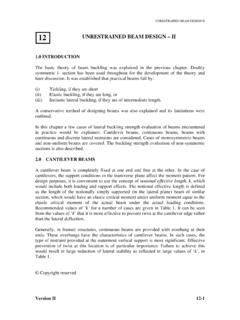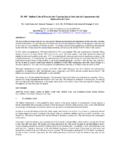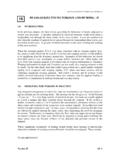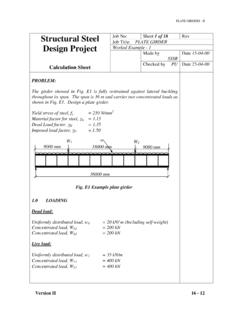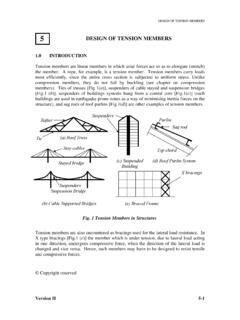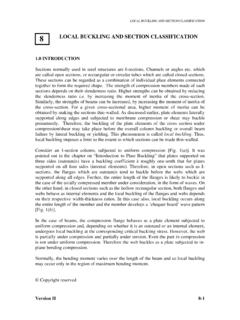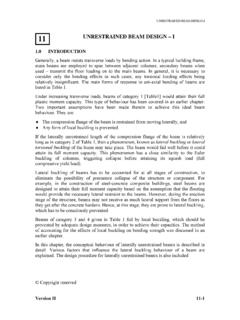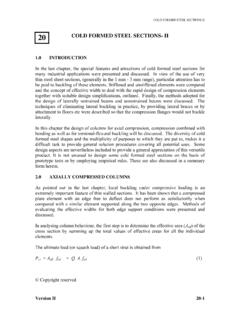Transcription of EARTHQUAKE RESISTANT DESIGN OF STEEL STRUCTURES
1 EARTHQUAKE RESISTANT DESIGN OF STEEL STRUCTURES Version II 45 - 1 EARTHQUAKE RESISTANT DESIGN OF STEEL STRUCTURES INTRODUCTION Earthquakes are natural phenomena, which cause the ground to shake. The earth s interior is hot and in a molten state. As the lava comes to the surface, it cools and new land is formed. The lands so formed have to continuously keep drifting to allow new material to surface. According to the theory of plate tectonics, the entire surface of the earth can be considered to be like several plates, constantly on the move.
2 These plates brush against each other or collide at their boundaries giving rise to earthquakes. Therefore regions close to the plate boundary are highly seismic and regions farther from the boundaries exhibit less seismicity. Earthquakes may also be caused by other actions such as underground explosions. The Indian sub-continent, which forms part of the Indo-Australian plate, is pushing against the Eurasian plate along the Himalayan belt. Therefore, the Himalayan belt is highly seismic whereas peninsular India, which is not traversed by any plate boundary, is relatively less seismic.
3 Earthquakes became frequent after the construction of Koyna dam and this is regarded as a classic case of man-made seismicity. However, the Latur EARTHQUAKE of 1993, which occurred in what was previously considered to be the most stable region on the earth implies that no region is entirely safe from devastating earthquakes. Earthquakes cause the ground to shake violently thereby triggering landslides, creating floods, causing the ground to heave and crack and causing large-scale destruction to life and property.
4 The study of why and where earthquakes occur comes under geology. The study of the characteristics of the EARTHQUAKE ground motion and its effects on engineered STRUCTURES are the subjects of EARTHQUAKE engineering. In particular, the effect of earthquakes on STRUCTURES and the DESIGN of STRUCTURES to withstand earthquakes with no or minimum damage is the subject of EARTHQUAKE RESISTANT structural DESIGN . The secondary effects on STRUCTURES , due to floods and landslides are generally outside its scope.
5 The recent EARTHQUAKE in Kutch, Gujarat on 26 Jan 2001 has not only exposed the weaknesses in the Indian construction industry but also the lack of knowledge about EARTHQUAKE engineering among all concerned. Taking advantage of the fear caused by the EARTHQUAKE in the minds of both the common people and the engineering community, a number of people who have no knowledge about EARTHQUAKE engineering have made totally absurd statements with regard to EARTHQUAKE RESISTANT DESIGN .
6 Examples are given below: Tall buildings (exceeding 27 metres) should NOT be built. (Comment: There is no scientific basis for this limitation). Copyright reserved 45 EARTHQUAKE RESISTANT DESIGN OF STEEL STRUCTURES Version II 45 - 2 A building of U or L shape (viz. Irregular shapes) is preferable. (Comment: Buildings of U or L shapes are under enhanced risk of EARTHQUAKE damage due to torsional mode of motions). Adjacent buildings should be rigidly interconnected. (Comment: It is inappropriate to connect adjacent buildings rigidly as re - entrant corners in such cases might undergo distress).
7 STEEL and Wood are ductile. (Comment: Wood is NOT ductile). It will be wise to verify the credentials of the so called experts with a view to ascertain if they are qualified to provide advice on EARTHQUAKE RESISTANT DESIGN , before believing or accepting their advice. An important thing to remember is that as of now, earthquakes cannot be predicted by any means scientific or otherwise. Claims that earthquakes can be predicted by Astrology, by Astronomical or other observations of sun-spots, by observing animals including rats and bandicoots or by observing unnatural phenomena such as sudden rise in the water table are all methods which have no scientific basis and should be regarded as extremely risky.
8 EARTHQUAKE load differs from other loads in many respects, which makes it more difficult to DESIGN for it. An important characteristic of EARTHQUAKE loading is the uncertainty associated with its amplitude, duration, and frequency content. STRUCTURES are normally designed to withstand gravity loads acting vertically with adequate factor of safety. Therefore the lateral loads arising due to horizontal EARTHQUAKE ground motion can cause severe damage unless special provisions are made to resist them.
9 The third characteristic of EARTHQUAKE ground motion is that it is cyclic and induces reversal of stresses. Therefore axially loaded members may have to resist both tension and compression while beam cross-sections will have to resist both positive and negative bending moments. The fourth characteristic is that the loading is dynamic and produces different degree of response in different STRUCTURES . Dynamic analysis requires the consideration of inertia and elastic forces as well as energy dissipating mechanisms like damping (Clough and Penzien 1993).
10 These characteristics make seismic analysis and DESIGN extremely difficult and time-consuming and so simplified procedures are often used in practice. DESIGN PHILOSOPHY AND METHODOLOGY Severe earthquakes have an extremely low probability of occurrence during the life of a structure . If a structure has to resist such earthquakes elastically, it would require an expensive lateral load resisting system, which is unwarranted. On the other hand, if the structure loses its aesthetics or functionality quite often due to minor tremors and needs repairs, it will be a very unfavourable DESIGN .
